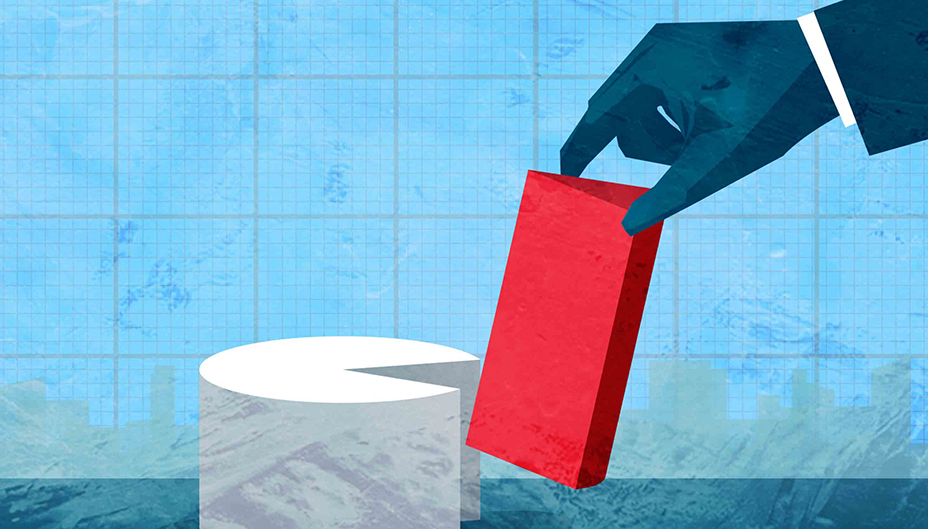Provincial Deficits Projected to Surge Due to COVID-19
Written by The Content Team
Published on April 28, 2020
minute read
Share:
Provincial governments across Canada are proposing historic financial support programs in response to the COVID-19 pandemic, with price tags in the billions. The flip side of all this aid funding will be hefty provincial deficits, which RBC Economics projects will grow more than six-fold in 2020. Intimidating as that sounds, RBC Economics notes that most provinces have experienced worse deficits in the past than the ones expected to come. Read the full report from RBC Economics below.
________________________
Pandemic to Spill Red Ink All over Provinces' Books
By RBC Economics
The COVID-19 pandemic is setting provincial government deficits on course to surge more than six-fold this year to almost $63 billion combined. Every province will see a material deterioration in its fiscal position. Still, the impact won't be the worst provinces have ever experienced (under our most likely scenario). We generally do not foresee any major problems with the financing of heftier deficits in the near term. If anything, liquidity support from the Bank of Canada will ensure funding channels stay open and funding costs remain manageable. We expect deficits to shrink significantly next year as the economy recovers though the fiscal scars from the pandemic will take a long time to heal—putting at risk provinces' credit ratings.
Unprecedented government response to COVID-19 is absolutely necessary… but expensive
The extraordinary measures put in place by all levels of government to cope with the pandemic and slow its spread increasingly appear to have succeeded in fending off worst-case health and economic scenarios. While this is encouraging news, these measures are coming with hefty price tags. The federal government's programs to protect health and safety, and directly support individuals and businesses in need total more than $230 billion (10% of GDP). Provinces' handling of the health emergency and rollout of their own financial support programs will run in the billions of dollars too. British Columbia ($5 billion), Alberta ($7.7 billion), Ontario ($17 billion) and Quebec ($18 billion), for example, put forward historic action plans. Clearly governments are seeing enormous spending pressures that will take a heavy toll on their fiscal position.
Recession delivers a massive blow to government revenue
Yet the expenditure toll could pale in comparison to the shock that's pummeling government revenues. The COVID-19 pandemic has triggered the most sudden and deepest recession we've ever seen. All but two provinces (British Columbia, and Newfoundland and Labrador) will experience their largest-ever single-year economic contraction, according to RBC Economics' latest Provincial Outlook update. This will ravage household and business incomes, and severely affect governments' major revenue sources. We expect personal and corporate income taxes, and sales taxes to fall markedly in every province this year. The revenue decline could be in the order of $3 billion in British Columbia (-6% of own-revenue), $6.3 billion in Ontario (-4.8%) and $8 billion in Quebec (-8.6%) based on historical sensitivity to economic growth.
Oil price collapse: a punch to oil-producing provinces' gut
Newfoundland and Labrador, Alberta and Saskatchewan face even more dramatic declines due to their dependence on oil royalties. We estimate the plunge in oil prices will slash those royalties by at least 40%. That's not even taking into account production cuts that are likely to occur in the face of a glut in global inventories. Including secondary effects on other parts of the economy, the energy sector tailspin could subtract more than $8 billion (or close to 20%) from revenue in Alberta this year.
Deficits everywhere…
COVID-19 has completely changed the fiscal outlook for all provinces. There will be deficits everywhere in 2020-2021. Big ones in the case of a couple of oil-producing provinces. We see the shortfall reaching close to $2 billion (7.0% of GDP) in Newfoundland and Labrador, and $18 billion (6.4%) in Alberta—or more than double the government's $6.8 billion projection in its February budget. Saskatchewan's lesser reliance on oil royalties will moderate its deficit to around $1.5 billion (2.1% of GDP). Ontario's relatively fresh $20.5 billion deficit projection (dated March 25) looks a little optimistic to us despite nearly $5 billion in contingencies built into the estimate. We believe it could exceed $21 billion (2.5% of GDP). Surpluses forecasted by BC, Quebec, New Brunswick and Nova Scotia in their 2020 budgets are no longer realistic. We expect deficits of the order of $5 billion in BC (1.8% of GDP), $13 billion in Quebec (3.0%), $600 million in New Brunswick (1.8%) and $800 million in Nova Scotia (1.9%). In the case of Quebec, our estimate excludes any transfers from the stabilization fund—which is merely an accounting guide, not a genuine fund. Our $1.5 billion projected shortfall in Manitoba (2.1% of GDP) will completely deplete the province's rainy day fund.
…though we've seen worse in the past
As dramatically as provinces' fiscal situation deteriorated over just a few weeks, 2020 deficits aren't likely to become the biggest ever relative to the size of the economy. Newfoundland and Labrador, and Alberta could come close. All other provinces experienced materially worse conditions at some point during the 1980s or 1990s. That said, grimmer scenarios cannot be excluded. Much about the health, economic and fiscal impact is uncertain at this point.
Provincial debt will grow a lot faster
Funding the big jump in deficits this year will require a substantial increase in debt issuance. That process is already underway with many provinces tapping the funding market repeatedly since the middle of March. We expect the increase in provincial net debt to more than triple overall this year.
The weight of that debt will get heavier…
All provinces will take on more debt at a time when their economy will shrink. This means net debt as a share of GDP will rise everywhere. Newfoundland and Labrador, with the highest net debt-to-GDP ratio (40%) along with Ontario at the outset, will see its indebtedness deteriorate the most—rising 19 percentage points by our estimate. At 59%, the province's ratio would be back to a level last seen in 2004-2005 and still below the record-high 69.5% recorded in 1998-1999. Alberta's indebtedness also is poised to jump (possibly by 7 percentage points) this year though from a very low base (10%). Alberta still has plenty of borrowing room it can use relative to its peers. Not so for Ontario, which has become the second-most indebted province since surpassing Quebec last year. Ontario nearly doubled its debt in the past decade. Its credit rating was downgraded as a result. Strong budget surpluses helped Quebec reduce its indebtedness significantly over the past five years, putting it in a stronger position than it was ahead of the 2008-2009 recession.
…but funding heftier deficits shouldn't be an issue near term
We don't see higher debt loads impeding provincial governments' ability to fulfill their growing borrowing needs in any material way. In a precautionary move, the Bank of Canada recently announced it will purchase up to $50 billion in provincial bonds in the secondary market with remaining maturities of 10 years or less. This will be in addition to the provincial money market purchase program it launched earlier. These moves should ensure liquidity in provincial funding channels. All provinces can presently borrow at historically low interest rates—which will help to contain the rise in debt service costs.
Light at the end of the tunnel… later this year?
COVID-19 will be a temporary shock to our economy. As we emerge from the health crisis—as PEI, New Brunswick and Saskatchewan appear to be on the cusp of—the economy and government revenue will start recovering. Our base case scenario has economic growth returning in the second half of this year. This should set the stage for lower budget deficits next fiscal year. Cleaning up all the red ink the pandemic spilled over provinces' books will take years though. Governments' revenue sources won't be fully repaired until the economic recovery is complete. Bringing down the mountain of debt will take even longer. COVID-19 will leave a lasting mark on provincial finances, which will put credit ratings at risk.
This report was authored by RBC Senior Economist, Robert Hogue, and RBC Economist, Ramya Muthukumaran.
RBC Direct Investing Inc. and Royal Bank of Canada are separate corporate entities which are affiliated. RBC Direct Investing Inc. is a wholly owned subsidiary of Royal Bank of Canada and is a Member of the Canadian Investment Regulatory Organization and the Canadian Investor Protection Fund. Royal Bank of Canada and certain of its issuers are related to RBC Direct Investing Inc. RBC Direct Investing Inc. does not provide investment advice or recommendations regarding the purchase or sale of any securities. Investors are responsible for their own investment decisions. RBC Direct Investing is a business name used by RBC Direct Investing Inc. ® / ™ Trademark(s) of Royal Bank of Canada. RBC and Royal Bank are registered trademarks of Royal Bank of Canada. Used under licence.
© Royal Bank of Canada 2025.
Any information, opinions or views provided in this document, including hyperlinks to the RBC Direct Investing Inc. website or the websites of its affiliates or third parties, are for your general information only, and are not intended to provide legal, investment, financial, accounting, tax or other professional advice. While information presented is believed to be factual and current, its accuracy is not guaranteed and it should not be regarded as a complete analysis of the subjects discussed. All expressions of opinion reflect the judgment of the author(s) as of the date of publication and are subject to change. No endorsement of any third parties or their advice, opinions, information, products or services is expressly given or implied by RBC Direct Investing Inc. or its affiliates. You should consult with your advisor before taking any action based upon the information contained in this document.
Furthermore, the products, services and securities referred to in this publication are only available in Canada and other jurisdictions where they may be legally offered for sale. Information available on the RBC Direct Investing website is intended for access by residents of Canada only, and should not be accessed from any jurisdiction outside Canada.
Explore More

Here’s What Every Canadian Should Know About Estate Planning
Insights from Leanne Kaufman to help you feel more confident as you plan
minute read

3 Things We're Watching This Week
What the Inspired Investor team is watching
minute read

What’s Driving the Recent Surge in Gold Prices
Here are some things to watch with the gold market
minute read
Inspired Investor brings you personal stories, timely information and expert insights to empower your investment decisions. Visit About Us to find out more.







